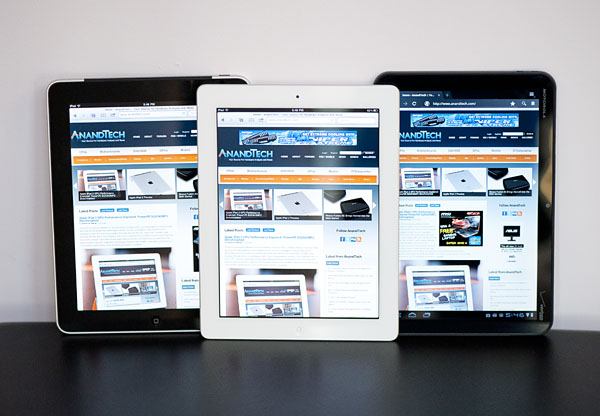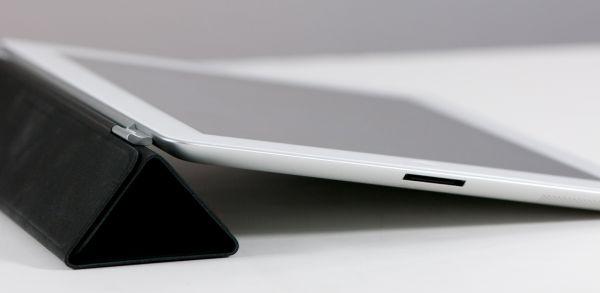Tablets: How Would You Solve the Input Problem?
by Anand Lal Shimpi on March 29, 2011 2:22 PM EST- Posted in
- Tablets
- Apple
- iPad 2
- Ask AnandTech
- Mobile
In our iPad 2 review I mentioned that despite really liking the device, I never really could integrate the original iPad into my daily life in a meaningful way. I always ended up traveling with the iPad and a notebook or while around town I just kept a smartphone on me. That limited my iPad use to pretty much lounging around at the house, and even then I found myself turning to the laptop more often than not.
With the Xoom and iPad 2 I've been giving the tablet usage model another try. I've kept my usage mostly consumption focused. Browsing the web and reading emails. I really do prefer using a tablet for both of these things. I do wish the iPad 2 was faster when selecting lots of emails but the improvement over the original iPad is still considerable.
My holdup is this: while I love reading on the iPad 2, I have troubles contributing using it. Writing lengthy email responses or even posting comments on AT is just slower on the iPad than on a notebook. The solution can't be to just walk over to a laptop when I want to respond and just use the iPad when I'm reading - that seems horrible inefficient.
I could use a Bluetooth keyboard but that's also rather clunky. I feel like there has to be a better solution going forward, particularly as the tablet market grows. Is it voice? Or some sort of an integrated kickstand with more flexibility than what you get with the smart cover?
I feel like smartphones get a pass because it's easy to type on them regardless of where you're sitting. Tablets on the other hand need to be propped up against something and as a result are harder to type on in certain situations. They work fine on a desk but if I'm at a desk I'd rather use a notebook. What about when laying back on a couch?
I'm curious what you all think about this. Am I alone in finding tablet ergonomics a barrier? If not, what do you believe is the best solution for tablets going forward. I want to read and respond on a tablet as quickly as I can on a notebook. What needs to be built? Post your comments here and I'm sure we can get many of the tablet manufacturers to pay attention. I don't think they have stumbled across the best solution for this problem either, so what you say here might go a long way in making tablets better for everyone.












247 Comments
View All Comments
erple2 - Thursday, March 31, 2011 - link
Wait. So you're implying that you've had your tablet that you work on for 5 years, and that it's i7 based? I'm confused now.y.a.k - Saturday, April 2, 2011 - link
The ThinkPad X series has a long tradition. He probably had some earlier model like X60 or X61 (Core Duo / Core 2 Duo based) and upgraded to X201. The one coming out now is X220 (Sandy Bridge).winterspan - Tuesday, March 29, 2011 - link
While attempting to get in a childish jab at the iPad, you completely missed the point. If your tablet has a physical keyboard then it is irrelevant to the issue at hand which is about finding a better input method that DOESN'T involve a built-in hardware keyboard (making the "tablet" a touch-screen laptop)seanleeforever - Wednesday, March 30, 2011 - link
lolz. why do i look down on ipad? i have an ipad for god sake. it is 299 nowadays, which is a drop in the bucket for me.again, i also have an android tablet because i wanted to see different platform, and i am more of a hands on person (my cell phone is Nokia N900).
i am simply answering anand question "I'm curious what you all think about this. Am I alone in finding tablet ergonomics a barrier? If not, what do you believe is the best solution for tablets going forward." a keyboard is a must for productive work. productive work like writing emails, creating/editing files. i have hard time to do anything effectively without keyboard.
i doubt an better input method would surface anytime soon. people have been using keyboard/mouse for 30 years, if there anything revolution, people would have invented already.
Penti - Wednesday, March 30, 2011 - link
People used light pens before mouses. Type writers before keyboards. Tools is what defines humans.The combination of keyboard, mouse and pen is here to stay and has had professional use for decades now. Wacom tablets do obviously have benefit over displays, in terms of ergonomics and so on. Drawing on a convertible tablet and handwriting recognition do obviously have a place even if we have moved on into touch based devices we control with our fingers directly and gestures. Touchpads and wacom tablets obviously have different use. Neither will go away. Keyboard is obviously the device which requires the least amount of effort when sitting in front of a screen, but handwriting has it's place, I doubt any one is sitting and swyping their notes in lectures.
We used to finger-paint before brushes, we airbrushed before digital editing and now we have digital brushes we control via mouse or pen.
hnzw rui - Wednesday, March 30, 2011 - link
+1 on handwriting recognition. Particularly so on slate form factors. I'm no fan of Vista but I'm pretty surprised at how well handwriting recognition works on my Fujitsu tablet running Vista Business. I find handwriting to be much better than using virtual keyboards for writing replies, emails, etc. Heck, I even find it comfortable enough to use for writing somewhat longer documents such as essays, etc. I guess that might have to do with the fact that when I was in elementary, computers weren't quite so commonplace and I had to write most of my papers long hand. :palonzo_riley - Wednesday, April 6, 2011 - link
Handwriting recognition?You've got to be kidding me. You must be an incredibly slow typist. I find that I'm so used to the quickness with keyboards that when I write now I start writing ahead of myself because my brain assumes I should have gotten that data out already!
SandmanWN - Wednesday, March 30, 2011 - link
Actually it just expands on the obvious. If they can put a slide out keyboard on a cell phone then why the crap can't they do it for a giant 10" tablet???A miniature keyboard that pulls out of a slot like the old stylus used to do and communicates with the tablet like a Bluetooth device. Seriously, where my friggin patent and billion dollars already.
blackcrayon - Saturday, April 2, 2011 - link
Yes, but that's exactly the type of "tablet" I would not be carrying with me very often, as it's much thicker, bulkier, and 3 times the weight of an iPad 2. There's certainly a tradeoff there between power and willingness to even have the thing casually with me.Connoisseur - Tuesday, March 29, 2011 - link
How about a Samsung Swype style pattern recognition system that's tailored to recognize finger presses rather than swiping movements? My thought is that it would recognize patterns in finger clicks based on relative location and timing of the fingers and form the best possible word based on that pattern. If implemented properly, it would alleviate the worst speedbump to productivity... not knowing what key you're pressing.Like every complicated idea, this sounds simple in theory but probably a nightmare to implement.